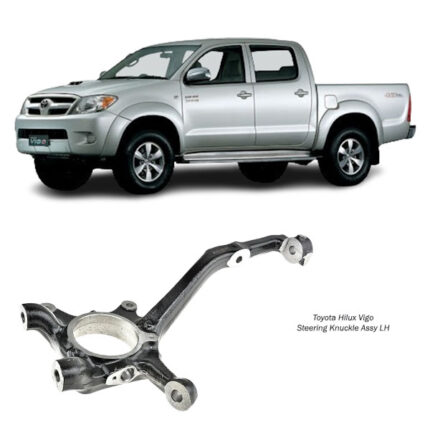Get Toyota Hilux Revo 2WD Steering Knuckle Assy RH 43211-KK030 in Kenya
The Steering Knuckle Assembly (Right-Hand Side, RH) is a crucial component of a vehicle’s steering, suspension, and braking system. It connects the wheel hub, suspension components, and steering linkage, allowing for precise wheel movement, stability, and braking efficiency.
A well-functioning steering knuckle ensures that the vehicle maintains proper alignment, smooth handling, and even braking distribution. If damaged, it can cause steering instability, uneven tire wear, and reduced braking performance.
This guide will cover everything you need to know about the Steering Knuckle Assy RH, including its function, components, materials, manufacturing process, common issues, maintenance, and replacement.
1. What is a Steering Knuckle Assembly (RH)? 🛠️
The steering knuckle acts as a pivot point that connects various parts of the steering and suspension system. It is located on the right-hand (RH) side of the front axle and plays a crucial role in controlling the movement and rotation of the wheel.
Key Functions:
✔️ Steering Control – Transfers motion from the steering system to the wheels.
✔️ Suspension Linkage – Connects to the ball joints and control arms for stability.
✔️ Brake System Support – Provides mounting points for the brake caliper and rotor.
✔️ Load Distribution – Helps distribute the vehicle’s weight while driving.
A faulty steering knuckle can cause poor handling, uneven braking, and vibrations.
2. Components of a Steering Knuckle Assembly (RH) ⚙️
The steering knuckle assembly consists of several important components that work together to ensure safe and smooth vehicle operation:
🔹 Knuckle Body – The main structure that connects the suspension and steering components.
🔹 Ball Joint Mounts – Attachment points for the upper and lower ball joints.
🔹 Tie Rod End Mounting Point – Connects to the steering linkage, allowing for directional control.
🔹 Wheel Hub Mounting Surface – Provides a secure connection for the wheel hub and bearings.
🔹 Brake Caliper Mounting Points – Supports the brake caliper and disc rotor for efficient braking.
Each component is engineered for strength and precision, ensuring optimal steering and suspension performance.
3. Materials Used in Steering Knuckles 🏗️
Since the steering knuckle experiences high amounts of stress and load, it must be made from durable materials. The most commonly used materials are:
a) Cast Iron 🏺
✔️ Strong and resistant to wear.
✔️ Heavier than other materials but highly durable.
✔️ Used in traditional vehicle designs.
b) Forged Steel 🔩
✔️ Stronger than cast iron and more resistant to impact.
✔️ Preferred for off-road and heavy-duty vehicles.
✔️ Can withstand high levels of stress.
c) Aluminum Alloy ⚡
✔️ Lighter than steel and resistant to corrosion.
✔️ Found in modern vehicles for improved fuel efficiency.
✔️ Less durable than steel but reduces overall weight.
d) Composite Materials 🏎️
✔️ Used in high-performance vehicles to reduce weight.
✔️ Offers a balance between strength and flexibility.
For high-stress driving conditions, forged steel steering knuckles are recommended due to their durability and toughness.
4. Manufacturing Process of a Steering Knuckle 🏭
The steering knuckle assembly undergoes a strict manufacturing process to ensure quality and precision. The key steps include:
1️⃣ Material Selection – Choosing high-strength metal or alloy.
2️⃣ Forging or Casting – Shaping the knuckle using heat and pressure.
3️⃣ Machining – Precision cutting, drilling, and milling to create mounting holes.
4️⃣ Heat Treatment – Strengthening the material to enhance durability.
5️⃣ Quality Control & Testing – Checking for defects, cracks, and alignment accuracy.
After production, each steering knuckle is tested to meet safety and performance standards.
5. Common Issues with Steering Knuckles 🚨
Over time, the steering knuckle can develop wear and damage due to driving conditions, heavy loads, and road impact. Here are some common issues:
a) Cracks & Fractures ⚠️
❌ Caused by heavy impacts, potholes, or accidents.
❌ Can lead to steering instability and potential failure.
b) Corrosion & Rust ⛓️
❌ Common in areas with high humidity, mud, or road salt.
❌ Weakens the structure and affects braking efficiency.
c) Worn-Out Mounting Holes 🏚️
❌ Over time, the ball joint and tie rod mounting holes can become loose.
❌ Leads to vibrations and poor handling.
d) Bent Knuckle 🛑
❌ A bent steering knuckle can cause wheel misalignment.
❌ Results in uneven tire wear and unpredictable steering.
If any of these issues arise, immediate replacement is recommended to prevent safety hazards.
6. Maintenance & Replacement of Steering Knuckles 🔧
a) How to Inspect Your Steering Knuckle 🕵️♂️
✅ Look for visible cracks, rust, or deformation.
✅ Check the ball joint and tie rod fitment for looseness.
✅ Ensure the brake caliper mounting points are secure.
✅ Watch for uneven tire wear or poor alignment.
b) When to Replace a Steering Knuckle? 🔄
🔹 If cracked, corroded, or bent, a replacement is necessary.
🔹 If the steering feels unstable or wobbly, check for excessive wear.
🔹 If the vehicle pulls to one side, the knuckle may be damaged.
c) Choosing the Right Replacement Steering Knuckle ⚙️
🚗 OEM (Original Equipment Manufacturer) parts – Ensure a perfect fit and high durability.
🔧 Aftermarket options – Some high-quality options exist, but compatibility must be verified.
🏁 Heavy-duty options – Ideal for high-load applications.
After replacing the steering knuckle, a wheel alignment is required to restore proper handling.
7. Installation Considerations 🔩
Replacing a steering knuckle assembly (RH) involves:
✔️ Removing the wheel, brake assembly, and suspension components.
✔️ Disconnecting the tie rod, ball joints, and hub assembly.
✔️ Installing the new knuckle and reattaching all components.
✔️ Performing a wheel alignment to ensure stability.
A professional mechanic is recommended for proper installation.
8. Conclusion 🎯
The Steering Knuckle Assembly (RH) is a key component in a vehicle’s steering, suspension, and braking system. A damaged or worn-out knuckle can lead to unsafe driving conditions, poor handling, and excessive tire wear.
💡 Key Takeaways:
✅ Regular inspection and maintenance can prevent costly repairs.
✅ Immediate replacement is necessary if the knuckle is cracked, rusted, or bent.
✅ OEM parts provide the best fit and durability.
✅ After replacement, a wheel alignment is crucial.
A well-maintained steering knuckle ensures safe and smooth vehicle operation.
Follow us on Facebook for more parts.






Reviews
Clear filtersThere are no reviews yet.